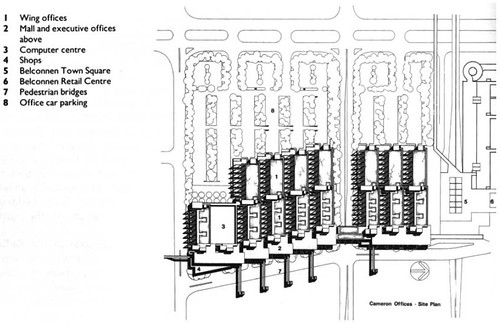One part of my early proposal, that I have mulled over for sometime but never pursued, was for a generative cityscape that remixed the geometry of Cameron Offices and other John Andrews or exemplar modern architectures.
I created a Generic City and continued refining it, while holding off on fitting a shape grammar to it as a skin. While it should be possible with a small amount of adaption to plug in almost any simple geometry (including non-orthogonal geometry by switching back to an 'off-lattice' Eden Growth Model which would require a different method of locating neighbouring cells), I felt that a shape grammar skin could be deterministic with highly structured relationships and that the open-ended further abstracted generic geometry was perhaps more robust in generating differentiation.
When for example I was considering a shape grammar for the Cameron Offices, I was immediately stuck with a couple of problems. All of the offices are oriented E-W to reduce direct sunlight (early morning / late afternoon). If I was to extend this endlessly it would be pretty boring - monotonous. This is the first problem - that Andrews did not design for variation: he designed in fixed modules (in a time before the changed economies of digital fabrication). Perhaps it would have been interesting to abstract further John Andrews grammar and introduce limited variance - but would this be true to Andrews? Probably I should have conceived this as an updating of his geometry appropriate for this time, that could be true if it didnt break any fundamental rules - whatever they might be. For example maybe I could decide that E-W orientation is not fundamental, but shading is - however if I introduced N-S orientation then I would have to design new shading and a way of turning corners. This is the second problem, I would have to design - the Cameron Offices does not have all of the information required for a shape grammar of an entire city, it is only a piece.
Andrews clearly understood his projects as systems or networks, designing them to be extended and connected with other projects. However the extensions he considered, for example the Bellmere Public School (see below), were a couple of additional modules. Andrews I doubt would intend the same geometry, even with minor variance, to be extended endlessly - particularly across different programs. This is made clear with the interface/connections at the boundaries of the Cameron Offices where Andrews designed pedestrian bridges to connect with housing but did not indicate any geometry or even massing for the housing, and further where he did sketch a town square and retail centre adjacent on the North the geometry is manifestly distinct. This principle is further reinforced later by the Bus Interchange where Andrews makes the pedestrian circulation circular tubes - a more obvious contrast to the adjacent Cameron Offices is not imaginable.
|
John Andrews, Cameron Offices, site plan from 'Australian Architecture Since 1960', 2nd Edition, 1990, Jennifer Taylor |
 |
| John Andrews, Cameron Offices and Belconnen Bus Interchange, Canberra, photo from 'John Andrews: Architecture a Performing Art' 1982, Jennifer Taylor & John Andrews |
Andrews shows how to make connections (pedestrian bridges), but as to what to connect to - well this could be almost any geometry. To illustrate the variety of Andrews geometries, and as a reminder of how significant an architect he has been, following is a selection of potential shape grammar seeds. Ultimately I felt that if I was designing I wanted it to be legible that it was my hand not Andrews and so I stayed with the generic geometry. Of course in the sense that Generic City is a system it is still closely associated with Andrews.
 |






















No comments:
Post a Comment